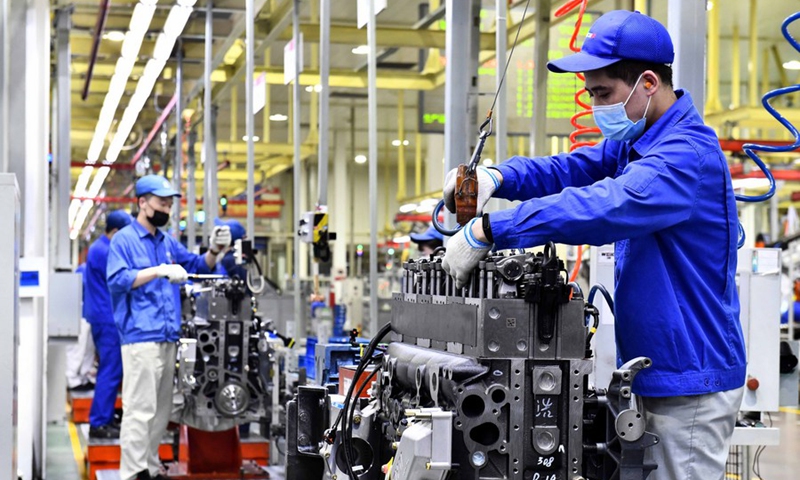
Workers assemble engines on an assembly line at a workshop of the Weichai Power Co., Ltd. in Weifang City, east China's Shandong Province, April 22, 2021. Photo: Xinhua
China's producers price index (PPI), a main gauge of factory price, gained 6.4 percent year-on-year in May, dropping for seven months in a row as global commodity prices eased and demands remained weak due to virus outbreaks in several manufacturing hubs.
The 6.4-percent gain in PPI, which is in line with market expectation, also compared with 8 percent growth in April, data from the National Bureau of Statistics (NBS) showed on Friday. It was the weakest reading since March 2021. In terms of month-on-month growth, China's PPI rose 0.1 percent in May, down 0.5 percentage point from the reading in April.
In May, China accommodated anti-epidemic efforts with social and economic development, ensured smooth and stable supply and industrial chains, which contributed to a moderation in both the month-on-month and year-on-year increase of PPI, Dong Lijuan, a senior statistician at the NBS, said in a statement posted on NBS' website on Friday.
The slowdown in PPI is also partly due to high base recorded last year, analyst pointed out, predicting that the year-on-year growth in China's PPI could continue dropping in the following months due to base effect, but the extent of decline could ease due to "geopolitical tensions, stretched supply chain and energy demand spikes in peak summer time."
Among the 40 industry categories, industries including coal mining, nonferrous metal smelting, petroleum, coal and other fuel processing as well as chemical raw materials and chemical manufacturing saw a slowdown in price increase, according to NBS data.
But analysts warned that the moderate PPI gain, which is partly manifested in the contraction territory China's manufacturing PMI has fallen into in May, also underscores the mounting downward pressure the world's second-largest economy faced.
They called for stabilizing policies to take effect as soon as possible, at a time when China's inflation is "relatively controllable," so that the second-quarter GDP could maintain reasonable growth.
The consumer price index (CPI), a main gauge of inflation, rose 2.1 percent year-on-year in May, a moderate increase that stayed at the same level in April and is also in line with economists' expectation.
In breakdown, food price jumped 2.3 percent year-on-year in May, up 0.4 percentage point from April, while non-food price soared 2.1 percent in May, down 0.1 percentage point from April.
Industry observers said that as pork price enters a period of rebounding, its repercussion effect on CPI will ease, which combined with an uptick in imported inflationary pressure, could mildly elevate China's CPI reading in the following months.
China's top market regulator on Friday issued a guideline on investigating and punishing illegal acts of bidding up price. Under the guideline, market regulators at various levels should improve emergency mechanism in handling abnormal market price fluctuation, and strengthen price supervision on key areas, procedures and commodities. They shall also publicize serious cases that have big social impact to make them play an alarming effect.
Global Times




